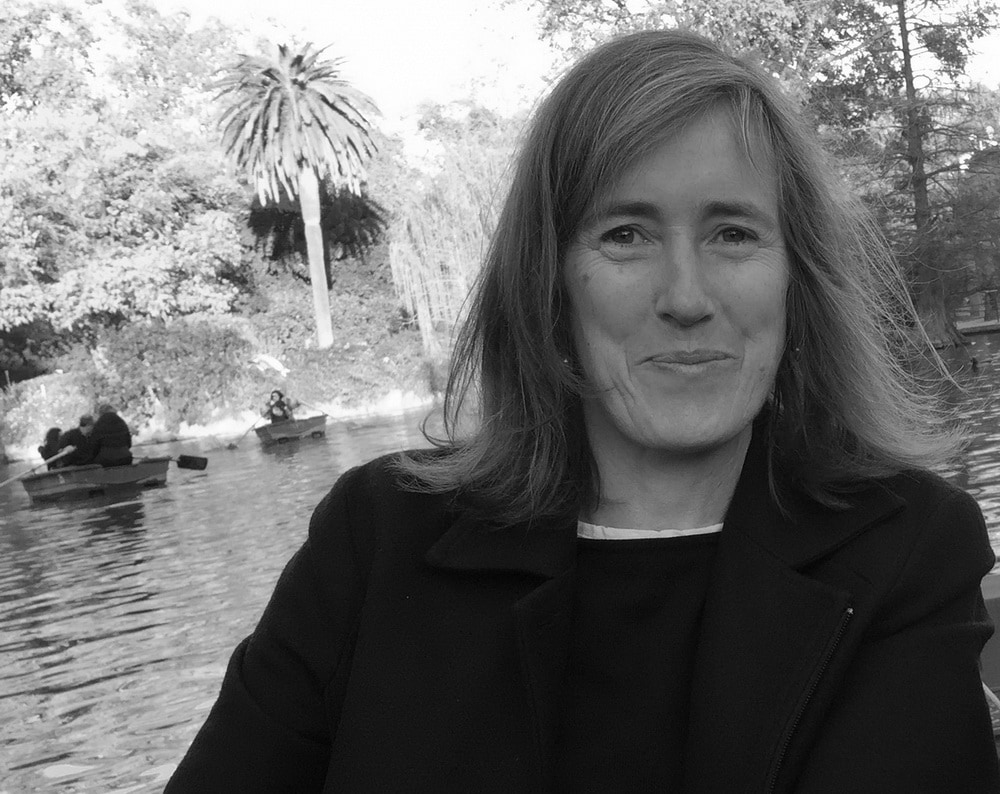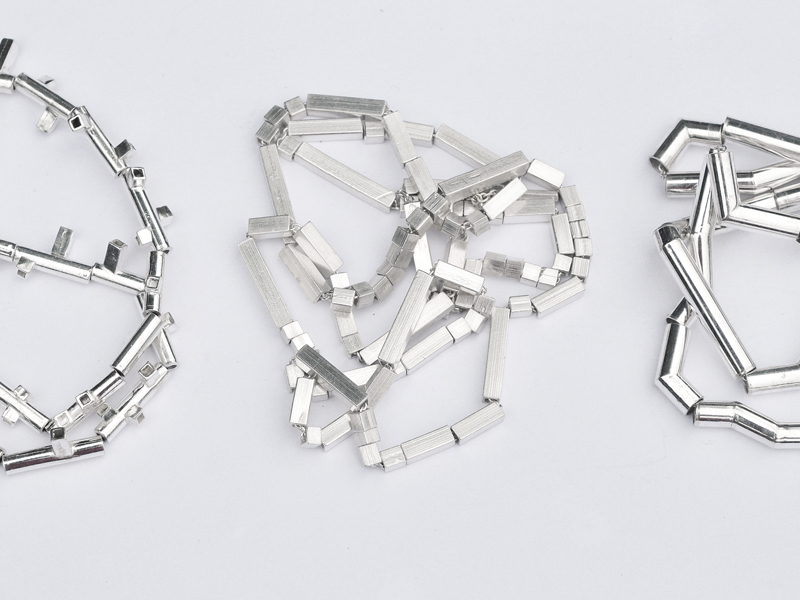
New Zealand jeweler Frances Stachl is exhibiting a new body of work, Bead, at The National in Christchurch, New Zealand. Frances like to set herself challenges, elaborates on her affair with the necklace, and talks about wearability, a key aspect informing her practice. She also speaks eloquently about being a production jeweler and how working at the more conceptual end of the contemporary jewelry spectrum can result in one-of-a-kind works that are in many ways like “changelings.”
Vicki Mason: Can you please give a little background about yourself? Where do you live, where did you train, and which encounters helped you shape your practice?
Frances Stachl: I live in Whanganui, above my workshop next to the river. I always call it a workshop because workshop feels like a crafty word, which is how I tend to define my practice—as being craft based. I studied painting briefly at Whanganui Polytech in the early 1990s before dropping out. Fine arts just didn’t feel like the right fit for me, though Whanganui Polytech did give me a very good base to start from in terms of learning to look objectively at my own work. I studied at Whitireia for two years after that, majoring in jewelry.
What has been a seminal experience during your making career?
Frances Stachl: Hmm. There are probably lots of little things. I’m not sure that they are seminal.
I was lucky during my time at Whitireia to attend workshops with several very good NZ jewelers. The three most memorable for me being Andrea Daly, Mary Curtis, and Alan Preston. I love the work of all of these jewelers because they had a very nice approach and way of thinking about jewelry-making. There was also a casting workshop with Karl Fritsch which was delightful because of the relaxed approach Karl brought to casting. Up until then I had imagined that casting was wildly technical and would require much testing and copious note-taking, rather than the easy joyful “suck it and see” trajectory the workshop took.

The animal ring series was quite a revelation. Up until that point I had been trying to establish myself as a serious jeweler who made serious necklaces. The animal rings were a sort of happy accident, worked quickly, modeled from wax and cast in silver. They reminded me that sometimes you just have to have fun in the workshop. They also sold much better than I had expected, showing me that serious was not the only valid approach.
A friend loaned me a copy of Peter Dormer’s book The Art of the Maker a year or so ago. There are lots of good things in the book that make good sense. I rather like the John Ruskin quote, “Do not … think that you can learn drawing, any more than any new language, without some hard and disagreeable labour.”[1]
On one hand I know that playing is crucial to keeping myself happy and satisfied within my practice. On the other hand I am quite well aware of the amount of discipline needed to maintain a functioning craft business.
Your exhibition is titled Bead. Can you tell us about your interest in the bead as a jewelry form?
Frances Stachl: I often find it tricky to explain to people what it is that I do. If I say I am a jeweler, there can be an assumption that I am a manufacturing or industry jeweler (think Michael Hill). If I try to clarify, the next conclusion is that I string up beads, which I sort of do, except I tend to make the beads myself. Bead-making is fairly central to my practice. I make lots of necklaces, and they are most often constructed by stringing up lots of little units rather than chain-making, though I do that as well. For a while I fought the bead label because I felt like there were craft-fair associations with bead stringing, but at some point I realized that actually it doesn’t matter too much what associations people make with words, what matters is that I am making jewelry.
Calling the new body of work Bead is a way of accepting the word, and of acknowledging the importance of that particular form of jewelry to my practice.
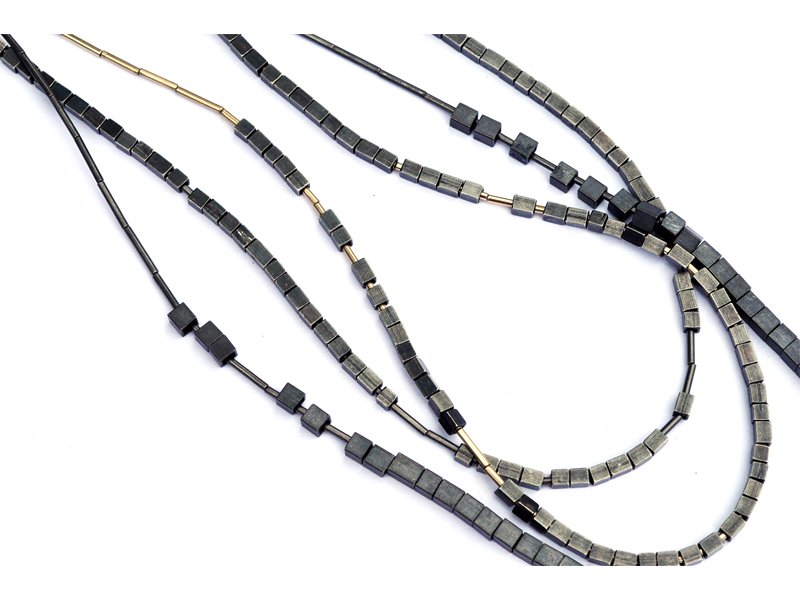
When did you start working on the series, and what ideas/concepts underpin it?
Frances Stachl: Ha. Poor Caroline, initially when we talked about me having an exhibition at The National, we discussed a completely different idea. I was going to make cast rings for this show. I made them, but I just didn’t feel like I was making the most of the opportunity, so I sent the rings away and got down to the business of necklace-making.
Necklaces are my first love, really. I feel like they offer me the most room to explore. I’m not sure how to talk about concept because mostly I don’t think I am a very conceptual jeweler. I like to make things that I think are visually beautiful, and one of the main rules I apply to my practice is that pieces need to be pleasing to wear. The necklaces in this show are mostly constructed from tube. I suppose it is process-driven rather than concept-driven. I really enjoy the process of drawing tube, and I like how simply it can be adapted and developed into a new thing with a few cuts and solders.
Can you tell us about the Holey and Sinker necklaces?
Frances Stachl: Holey is one of those games you play in the workshop to keep yourself entertained and to hone your skills, or, in my case, tighten up your sloppy habits. When I started jewelry-making, I used to go through ridiculous quantities of disposables, piles of twist drills, stacks of saw blades. Not because I was especially prolific, but because I wasn’t using the tools to their best potential.
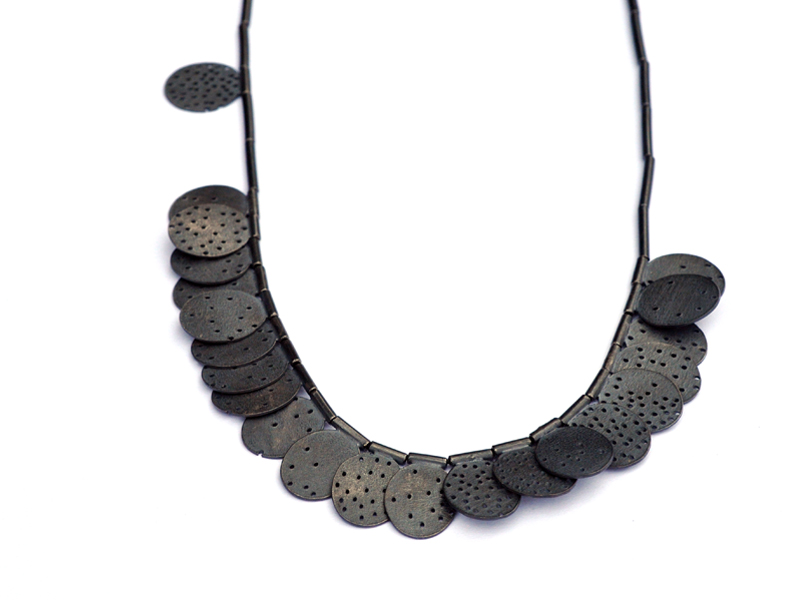
At some point I decided to set some challenges for myself. The challenge for Holey was to see how many holes I could make using a single drill bit. There are two versions of Holey in the exhibition, one with a shorter section of holey discs and one with a longer section of holey discs using patience and lots of burr wax. The decorative section of each necklace is dictated by the life of a single drill bit.
Sinkers is the reworking of a piece I made about a decade ago based on a pile of homemade cast-lead fishing weights my mother found in her father’s garage. The original piece came back to me recently for a restring and until seeing it again I had forgotten I had made it. I thought it was rather nice but that if I made it now I would do it differently. The original features the same number of sinkers spaced evenly around the necklace, giving a much more formal feel. I like the bunch-of-grapes effect when they were clustered close together.

This work has a quiet simplicity about it (minimal use of color, restricted repeated forms/shapes/patterns, etc.) when compared to earlier works that seemed to have more to do with material reassignment of known objects (I am thinking of Squeeze, The Baby and the Bathwater, or Ashes in Your Mouth). Can you tell us what spurred this shift toward a more restrained palette?
Frances Stachl: Hmmm. This question threw me a bit because for me works like Squeeze, The Baby and the Bathwater, or Ashes in Your Mouth feel like the odd ones out in my practice. Most of my work until a few years ago was all about the formal concerns of the necklace. I’ve mostly seen myself as a studio production jeweler, rather than an exhibiting jeweler. I make the bulk of my income from jewelry-making, so the pieces like Squeeze, etc., are fun, but often feel like an indulgence. They do not pay the rent so they happen less often. The formal process-driven pieces feel like a much more natural way to work and often the formal concerns raised in one piece might end up trickling into the next piece. At its best each piece informs the next. The literal pieces tend to be one-offs, maybe because they are based on things which already exist so they are about resolving a concept rather than formal concerns. I know what a plug looks like already, so once I have made several I don’t feel like I need to keep going because a plug is already resolved.
I’m also quite attached to the production pieces, they feel like my true children, where the fancy attention-grabby stuff can occasionally feel a bit like changelings sometimes.
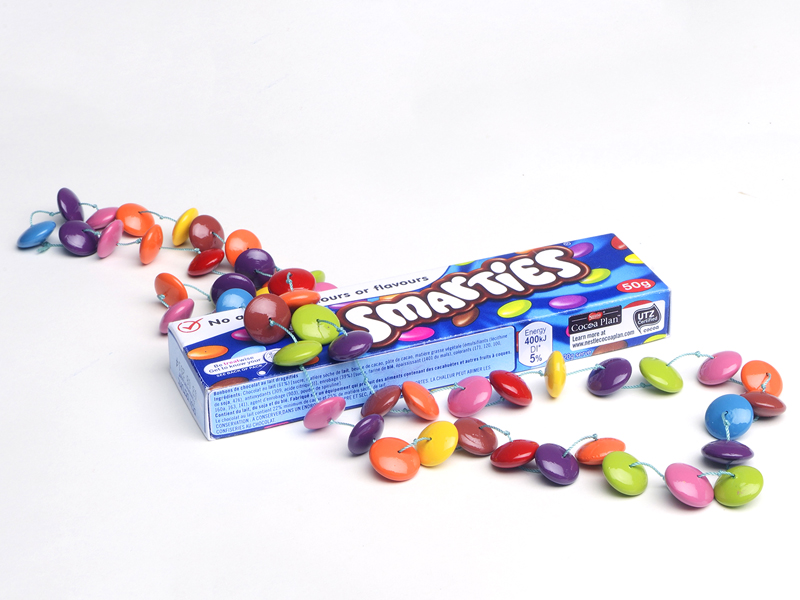
This is also a move toward less literally evocative work. Are you more interested in the challenges of form-making than you used to be?
Frances Stachl: See above. Form-making is an old love. The necklace offers so much room to move. Simple elements repeated are quite comforting to make, and I enjoy the way things change and gain weight when you have lots of them together. I am a bit obsessive-compulsive at times, and this sort of work is a productive and useful place to employ that part of my personality.
Did you make all the constituent parts yourself?
Frances Stachl: Most of it, though I did buy manufactured chenier for the corner beads and also the fine chain they are strung on. I like making tube, but for the corner beads I wanted seamless tube, and handmade chenier has a seam. When I left Polytech I had some quite lofty ideals about melting and milling all my own stock metal. Occasionally I still do this because I quite like the process, but I mostly just buy sheet and wire and only do a little milling. I do usually make my own tube and draw down a fair bit of wire, mainly because it makes me feel all muscular and superwoman-like.
I think that this is your first show in The National’s new space. Was it an exciting space to work with? Can you tell us how you installed the work in the gallery?
Frances Stachl: Yes, it is my first show in The National’s new space. I didn’t install it myself, I sent it down and Caroline very nicely installed it for me. Caroline has dealt with my work for a while and I always feel confident that she will display work in a way that is in keeping with my aesthetic.
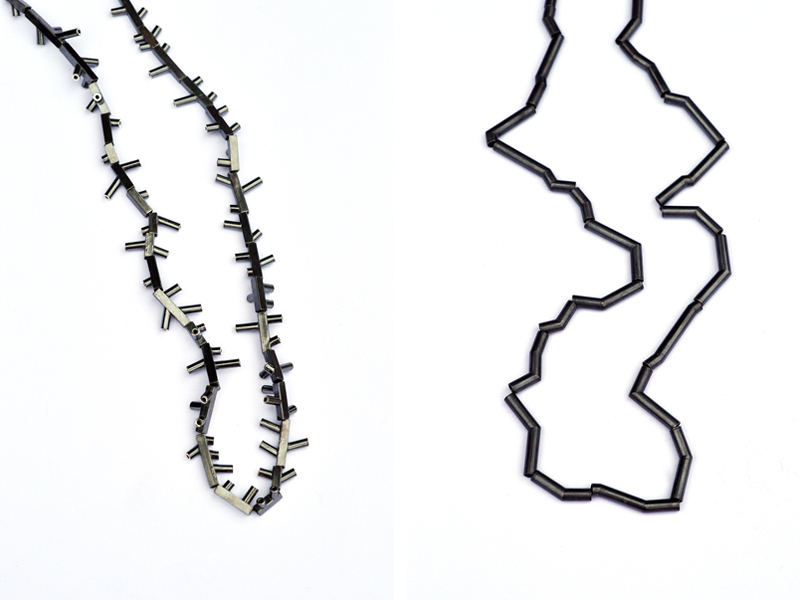
What are you reading at the moment?
Frances Stachl: I’ve just finished reading The Natural Way of Things, by Charlotte Wood. I picked it up because I thought the cover was beautiful and I was looking for something to add to the communal bin at the book club I go to. I haven’t added it to the book club bin just yet—partly because I want to read it again, and partly because there were bits of it that are a bit harrowing.
I do often choose books based on the cover though I know one is not supposed to. I tell myself that, as a maker, choosing beauty is not such an surprising thing, and it usually works out. Next on my summer reading list is Harper Lee’s Go Set a Watchman, which a friend loaned me last year and which I have been avoiding because I am convinced that it will not be as good as To Kill a Mockingbird.
Where do you think contemporary jewelry is headed?
Frances Stachl: Hmmm. Hopefully to a neck, wrist, or finger near all of us? I don’t know. I think I might be a bit old school in my approach to jewelry. I tend to like things that are well made, but that doesn’t really say much about where contemporary jewelry might be headed.
I’m not entirely comfortable with the “jewelry as art” model, yet I know that thinking beyond tradition is part of what keeps jewelry interesting. I’m quite enjoying seeing more images of jewelry on people rather than as isolated catalog objects. I think you can’t simply have wearable jewelry without also having the show-pony exhibition stuff. They both need each other in order to stay interesting.
What would be your dream jewelry gig?
Frances Stachl: I think I might have it already. I’m pretty lucky, really. I get to make jewelry for a living. Sometimes the pay is a bit unpredictable, and self-employment is occasionally tricky to get one’s head around, but at the end of the day, I do what I love.
The works in this exhibition were priced between NZ$725 and $2,200 (US$480 and $1,460).
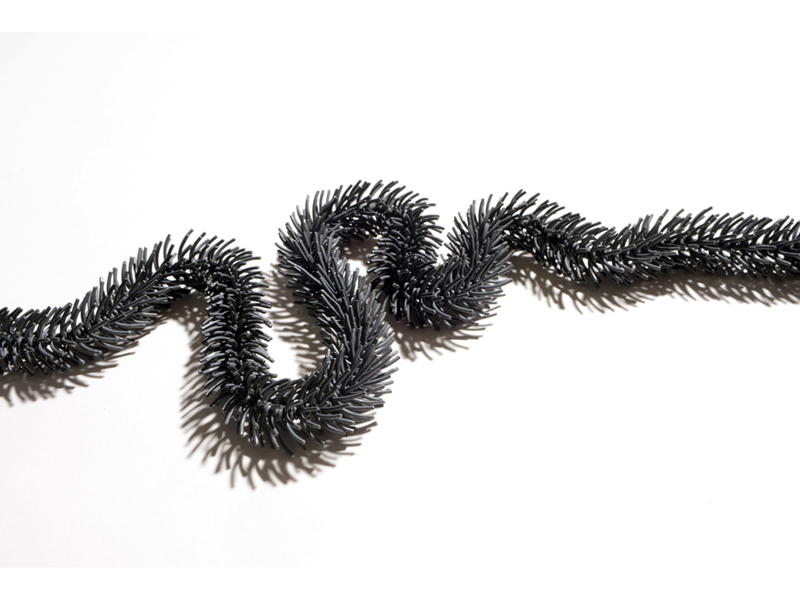
INDEX IMAGE: Frances Stachl, Farm Beads & Joiner Beads, 2015, necklaces, 70 x 355–385 mm long, photo: The National
[1] John Ruskin, The Elements of Drawing, Letter I, On First Practice (written in 1856, first published in 1857). Available online at https://ebooks.adelaide.edu.au/r/ruskin/john/drawing/letter1.html.
